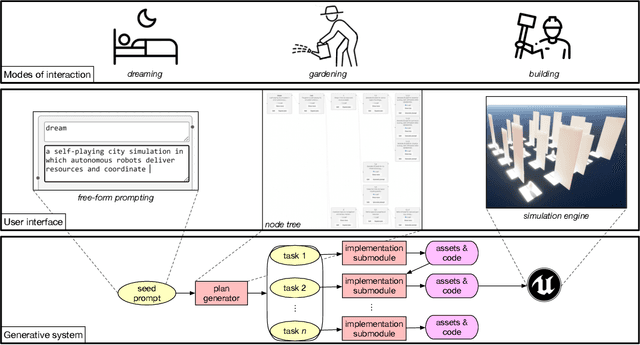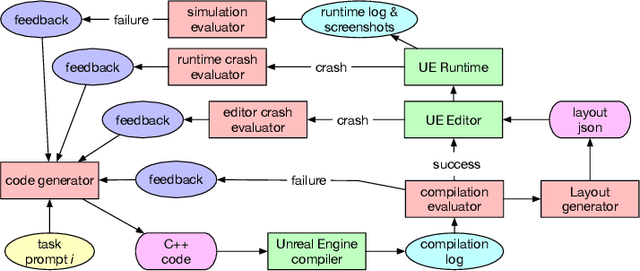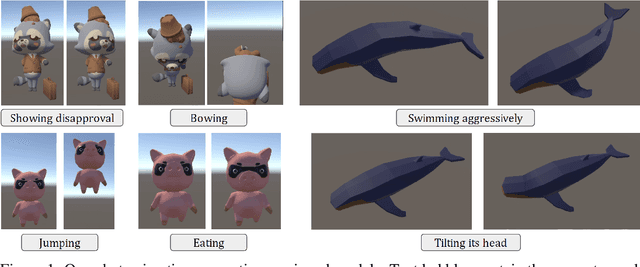Andrzej Banburski-Fahey
DreamGarden: A Designer Assistant for Growing Games from a Single Prompt
Oct 02, 2024



Abstract:Coding assistants are increasingly leveraged in game design, both generating code and making high-level plans. To what degree can these tools align with developer workflows, and what new modes of human-computer interaction can emerge from their use? We present DreamGarden, an AI system capable of assisting with the development of diverse game environments in Unreal Engine. At the core of our method is an LLM-driven planner, capable of breaking down a single, high-level prompt -- a dream, memory, or imagined scenario provided by a human user -- into a hierarchical action plan, which is then distributed across specialized submodules facilitating concrete implementation. This system is presented to the user as a garden of plans and actions, both growing independently and responding to user intervention via seed prompts, pruning, and feedback. Through a user study, we explore design implications of this system, charting courses for future work in semi-autonomous assistants and open-ended simulation design.
Real-time Animation Generation and Control on Rigged Models via Large Language Models
Oct 27, 2023



Abstract:We introduce a novel method for real-time animation control and generation on rigged models using natural language input. First, we embed a large language model (LLM) in Unity to output structured texts that can be parsed into diverse and realistic animations. Second, we illustrate LLM's potential to enable flexible state transition between existing animations. We showcase the robustness of our approach through qualitative results on various rigged models and motions.
LLMR: Real-time Prompting of Interactive Worlds using Large Language Models
Sep 21, 2023Abstract:We present Large Language Model for Mixed Reality (LLMR), a framework for the real-time creation and modification of interactive Mixed Reality experiences using LLMs. LLMR leverages novel strategies to tackle difficult cases where ideal training data is scarce, or where the design goal requires the synthesis of internal dynamics, intuitive analysis, or advanced interactivity. Our framework relies on text interaction and the Unity game engine. By incorporating techniques for scene understanding, task planning, self-debugging, and memory management, LLMR outperforms the standard GPT-4 by 4x in average error rate. We demonstrate LLMR's cross-platform interoperability with several example worlds, and evaluate it on a variety of creation and modification tasks to show that it can produce and edit diverse objects, tools, and scenes. Finally, we conducted a usability study (N=11) with a diverse set that revealed participants had positive experiences with the system and would use it again.
Reprompting: Automated Chain-of-Thought Prompt Inference Through Gibbs Sampling
May 17, 2023Abstract:We introduce Reprompting, an iterative sampling algorithm that searches for the Chain-of-Thought (CoT) recipes for a given task without human intervention. Through Gibbs sampling, we infer CoT recipes that work consistently well for a set of training samples. Our method iteratively samples new recipes using previously sampled solutions as parent prompts to solve other training problems. On five Big-Bench Hard tasks that require multi-step reasoning, Reprompting achieves consistently better performance than the zero-shot, few-shot, and human-written CoT baselines. Reprompting can also facilitate transfer of knowledge from a stronger model to a weaker model leading to substantially improved performance of the weaker model. Overall, Reprompting brings up to +17 point improvements over the previous state-of-the-art method that uses human-written CoT prompts.
Steps towards prompt-based creation of virtual worlds
Nov 10, 2022Abstract:Large language models trained for code generation can be applied to speaking virtual worlds into existence (creating virtual worlds). In this work we show that prompt-based methods can both accelerate in-VR level editing, as well as can become part of gameplay rather than just part of game development. As an example, we present Codex VR Pong which shows non-deterministic game mechanics using generative processes to not only create static content but also non-trivial interactions between 3D objects. This demonstration naturally leads to an integral discussion on how one would evaluate and benchmark experiences created by generative models - as there are no qualitative or quantitative metrics that apply in these scenarios. We conclude by discussing impending challenges of AI-assisted co-creation in VR.
 Add to Chrome
Add to Chrome Add to Firefox
Add to Firefox Add to Edge
Add to Edge